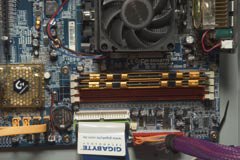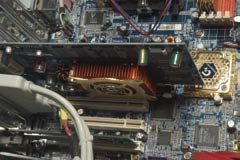articles/Computers/bigcomputers-page2
Big Computers - part 2 of 1 2 3
by Mark McNamee Published 01/04/2005

RAM has been pressed into service the, CPU shuffles the in-progress data out to the "Scratch Drive", the so-called virtual memory and things start to slow down. More RAM delays the onset of this problem and, once it occurs, faster hard drives help to reduce the delays. Photoshop can only use the first 2GB of RAM and so we elected to stop right there! The only decision then is whether to make up the 2GB from four 500MB modules or two 1GB. They are best purchased in matched pairs. We elected to go for the more expensive option of 2x1GB to provide more headroom for expansion (ie we only use two slots on the motherboard). This cost £255.
The Graphics Card
The graphics card operates your monitor and shows you what is going on. A slower card causes the mouse movements to jitter when using large brushes in Photoshop and, at its worst, will make programs like Corel Painter and Illustrator impossible to use effectively. Typical memory on graphics cards ranges from 64MB to 256MB. In reality, only a small portion of this is allocated to 2-D operation (eg Photoshop) and the really high-end cards costing many hundreds of pounds are not a good investment unless you are a gaming freak. We specified a 256MB card, costing £80.
Hard Drives
Efficient and secure operation demands at least two hard drives, one for your operating system and one for storing your images, accounts etc. Photoshop needs at least one drive to be specified as its scratch drive and ideally this should not be the one that it is using to run itself. On some of our workstations we have three drives (not partitions - discrete drives) one of which is kept purely as a scratch drive.
Hard drive operating speed is a very complex subject and there are as many opinions as there are arrangements. One method of speeding things up is to use a RAID array - a Redundant Array of Inexpensive Disks. This allows a group of disks to operate as a single unit of greater speed, greater reliability or both. Some speed merchants like the Western Digital Raptors, which have a considerable reputation. However they are relatively expensive (£66 for 37GB or £102 for 74 GB) compared to our selection of Maxtor 250GB at £85 each. We specified six of these in two RAID arrays; one for speed, one for reliability and speed giving two effective drives of 500MB each. In addition we have a free standing LaCie Big Disk of 500MB capacity.

The Motherboard
The motherboard had to accommodate all we have planned for it, including the ability to support two RAID arrays from six drives, two DVD drives and two CD drives. In addition we had to have Firewire 800 capability and USB 2 as well as the usual sound cards and 1 Gbit networking. We specified this in a motherboard costing £102 - they are relatively good bargains for what they do!
The Rest of the Bits
The additional bits and pieces consisted of two DVD drives, a reader and a reader/writer. We just bought the ones available on the website. In general ones made in Japan have a more reliable performance than those made in China (as we found to our cost), however they are so cheap as to not make a big dint even when they go wrong. We also installed two old CD drives from the dead machine. We find sometimes that CDs that cannot be read on a fast drive will be read on an old, slow drive. We also installed a dedicated seven-card reader.
This little lot required a rather large cabinet and we chose the Coolmaster case with its 11 bays. To keep the drives cool we installed the four-drive RAID in a dedicated three-drive bay with forced cooling. The machine actually weighs a tremendous amount and we were grateful for the base castors, which enable it to be pushed around the floor with ease, and then parked with locked castors. The case cost £87 excluding a beefy power supply with a large, slow and silent cooling fan, essential for comfort of the ears.
Performance
The computer is extremely quick; some Photoshop operations were too quick to record on the Timing function. Photoshop opens in 6 seconds compared to 20 seconds on the older number one machine (1.8GHZ 1GB RAM). This speed increase was replicated over many typical operations. Saving and opening of files on the RAID arrays is particularly quick improved more than 6-fold on non-RAID drives. Using Photoshop with large brushes was significantly smoother and operations such as Lens Blur were improved by about the same ratios as other operations.
Please Note:
There is more than one page for this Article.
You are currently on page 2 Contact Mark McNamee
1st Published 01/04/2005
last update 09/12/2022 14:51:40
More Computers Articles
There are 16 days to get ready for The Society of Photographers Convention and Trade Show at The Novotel London West, Hammersmith ...
which starts on Wednesday 14th January 2026





